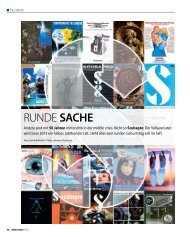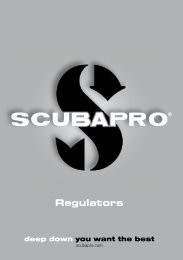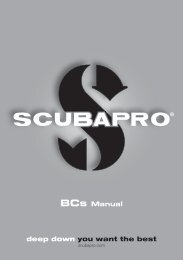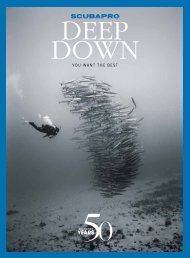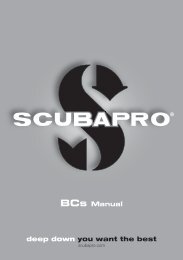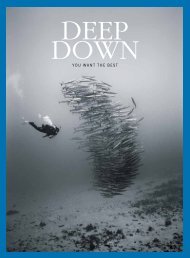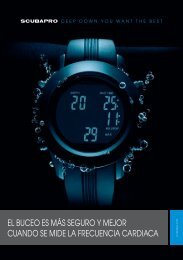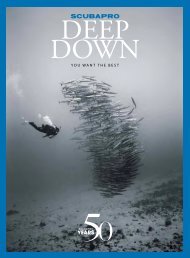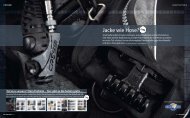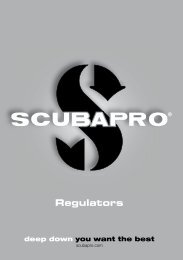Regulators user manual - Scubapro
Regulators user manual - Scubapro
Regulators user manual - Scubapro
Create successful ePaper yourself
Turn your PDF publications into a flip-book with our unique Google optimized e-Paper software.
EN 250: 2000 SCUBAPRO CERTIFIED COMBINATIONSEN 250: 2000 SCUBAPRO ZERTIFIZIERTE KOMBINATIONENCOMBINAISONS CERTIFIÉES SCUBAPRO NORME EN 250: 2000EN 250: 2000 COMBINAZIONI CERTIFICATE SCUBAPROEN 250: COMBINACIONES CERTIFICADAS 2000 DE SCUBAPROSCUBAPRO COMBINATIES GECERTIFICEERD CONFORM EN 250:2000EN 250: 2000 COMBINAÇÕES CERTIFICADAS DA SCUBAPROСтандарт EN 250: 2000 СЕРТИФИЦИРОВАННЫЕ КОМБИНАЦИИ SCUBAPROEN 250: 2000 SCUBAPRO ÁLTAL HITELESÍTETT KOMBINÁCIÓKATESTOWANE ZESTAWY SCUBAPRO ZGODNE Z EN250: 2000EN 250: 2000 CERTIFIKOVANÉ KOMBINACE SCUBAPROEN 250: SCUBAPRO KOMBINACIJE CERTIFICIRANE PREMA STANDARDU 2000EN 250: 2000 SCUBAPRO CERTIFIERADE KOMBINATIONERSCUBAPRO - COMBINATII CERTIFICATE EN250:2000CE 認 証 されている 組 み 合 わせEN 250: 2000 SCUBAPRO 认 可 的 组 合FIRST STAGE / Erste Stufe / Premier Etage /Primo Stadio / Primera Etapa / Eerste Trap / Primeiro Estágio / Первая Ступень /Első Lépcső / Pierwszy Stopień / První Stupeň / Prvi Stupanj / Första steg / Treapta I / 一 级 头 / ファーストステージMK25 TINT/DINMK25INT/DINMK2 PlusINT/DINMK17INT/DINMK11INT/DINMK25 NITROXEN 144-3MK2 Plus NITROXEN 144-3Second Stage / Zweite Stufe / Deuxieme Etage / Secondo Stadio / Segunda Etapa / Tweede Trap / Segundo Estágio / вторая Ступень/ Második Lépcső / Drugi Stopień / Druhý Stupeň / Drugi Stupanj / Andra steg / Treapa a-II-a / 二 级 头 / セカンドステージA700 g gS600 TgS600 g gG260 g gG250 V g gC300/C200 g g g gR295 g g g gR195 g g g gR095 g g g gC200 OCTOPUS g g g g gR295 OCTOPUS g g g g gR195 OCTOPUS g g g g gR095 OCTOPUS g g g g gS555 NITROXR295 NITROX g gR195 NITROX g gR295 NITROXOCTOPUSR195 NITROXOCTOPUSggggg
SCUBAPRO REGULATORS ManualCongratulations on purchasing a SCUBAPRO regulator and welcome to SCUBAPRO.We are confident that you will enjoy extraordinary performance from our regulator,designed and manufactured using the most advanced technology.We thank you for choosing SCUBAPRO and wish you a future of safe dives andunderwater enjoyment!EnglishTABLE OF CONTENTS1. Important warnings 22. CE Certification 22.1 EN 250: 2000 norm regulations and what they mean 22.2 Definition of ‘SCUBA’ according to EN 250: 2000 22.3 Limitations provided by EN 250: 2000 23. Important warning reminders 34. Regulator system 34.1 First stage 44.2 Second stage 45. Technical features 45.1 First Stages 55.2 Second Stages 65.3 First and second stage features 76. Preparing for use 96.1 Set-up/in-use warning 97. Equipment use 107.1 Second stages with Venturi effect (V.I.V.A.) adjustment 107.2 Cold water use 117.3 Post dive 118. Equipment care and maintenance 128.1 Care 128.2 Maintenance 139. Nitrox 139.1 Main features of Nitrox dedicated regulators 149.2 Use and maintenance notes 1410. Troubleshooting 151
1. IMPORTANT WARNINGS! WARNINGThis <strong>manual</strong> must be read and understood entirely before using the product. It is advisedthat you keep this <strong>manual</strong> in your possession during the entire life of your regulator.! WARNINGWhen diving you must follow the rules and apply the skills taught by a recognizedscuba diving certification agency. Before taking part in any diving activity, it ismandatory to have successfully completed a scuba diving course covering boththeoretical and technical aspects of diving.! WARNINGThis instruction <strong>manual</strong> does not replace a diving instruction course!2. CE CERTIFICATIONAll SCUBAPRO regulators described in this <strong>manual</strong> have obtained the CE certification issuedby RINA according to European directive 89/686/EEC. Certification tests have been conductedaccording to the specifications set by the said directive, regulating the conditions for the releaseon the market and the fundamental safety requirement for third category Personal ProtectiveEquipment (PPE). The CE mark denotes compliance with the fundamental requirements forhealth and safety. The 0098 number next to the CE marking is the identification code forGermanischer Lloyd, the notified body controlling production compliance with regulations, asper Art. 11 A ED 89/686/EEC. The Manufacturer of SCUBAPRO regulators is SCUBAPROEUROPE s.r.l. Via Tangoni 16 16030 Casarza Ligure (GE) Italy.2.1 EN 250: 2000 norm regulations and what they meanThe requirements and tests defined by the EN 250: 2000 standard aim to ensure a minimumsafety level for the operation of underwater breathing equipment. In Europe, the EN 250:2000 norm defines the minimum technical standards of acceptance for recreational divingregulators. All SCUBAPRO regulators have successfully passed the certification test requiredby this regulation.2.2 Definition of ‘SCUBA’ according to EN 250: 2000This regulation defines a SCUBA unit as a self-contained open-circuit underwater breathingapparatus. A SCUBA unit can be composed of component groups. During use, the minimumrequired component groups are elements a) to e) of the following list:a. cylinder(s) with valve(s);b. demand regulator(s);c. safety device(s);d. face mask: complete mouthpiece or half-mask for diving or complete mask;e. carrying system.2.3 Limitations provided by EN 250: 2000The SCUBA unit can be comprised of separate components such as: cylinder(s), regulator(s),pressure gauge. The SCUBAPRO regulators described in this <strong>manual</strong> can be used withSCUBA components units certified according to directive 89/686/EEC and EN 250: 2000norm. The air contained in the cylinder must comply with the requirements for breathable airdefined by EN 12021 norm. The maximum operating depth is 50 meters (164 ft.) howeverdivers must conform to the limits set by local regulations in force at the diving location.2
! WARNINGA SCUBA unit complying with the requirements of the EN 250 norm is not designedto supply more than one diver at a time.If the SCUBA unit is used simultaneously by more than one diver, breathing and coldwater performance may no longer satisfy the requirements set forth by EN 250 norm.English3. IMPORTANT WARNING REMINDERSFor your protection while using SCUBAPRO life support equipment, we call your attentionto the following:1. Use the equipment according to the instructions contained in this <strong>manual</strong> and only afterhaving completely read and understood all instructions and warnings.2. Use of the equipment is limited to the uses described in this <strong>manual</strong> or for applicationsapproved in writing by SCUBAPRO.3. Cylinders must only be filled with atmospheric compressed air, according to theEN 12021 norm. Should moisture be present in the cylinder, beside causing corrosionof the cylinder, it may cause freezing and subsequent malfunction of the regulator duringdives carried out in low temperature conditions (lower than 10°C (50°F)). Cylinders mustbe transported according to local rules provided for the transport of dangerous goods.Cylinder use is subjected to the laws regulating the use of gases and compressed air.4. Equipment must be serviced by qualified personnel at the prescribed intervals. Repairsand maintenance must be carried out by an Authorized SCUBAPRO Dealer servicefacility and with the exclusive use of original SCUBAPRO spare parts.5. Should the equipment be serviced or repaired without complying with proceduresapproved by SCUBAPRO or by untrained personnel or not certified by SCUBAPRO, orshould it be used in ways and for purposes other than specifically designated, liability forthe correct and safe function of the equipment transfers to the owner/<strong>user</strong>.6. If the equipment will be used in cold water (temperature lower than 10°C (50°F)) it will benecessary to use a regulator suited for such temperatures.! WARNINGDiving in cold water requires special equipment and techniques. Before diving incold water we strongly recommend you obtain adequate training from a recognizedtraining agency.7. The content of this <strong>manual</strong> is based upon the latest information available at the time ofgoing to print. SCUBAPRO reserves the right to make changes at any time.SCUBAPRO refuses all responsibility for damages caused by non-compliance with theinstructions contained in this <strong>manual</strong>. These instructions do not extend the warranty or theresponsibilities stated by SCUBAPRO terms of sales and delivery.4. REGULATOR SYSTEMA regulator system is required to reduce the pressure of the compressed air contained inthe cylinder to an ambient pressure in order to supply breathable air when needed. It is alsopossible to connect pressure gauges (analog or digital), IP inflators to supply buoyancycompensators, dry suits and other devices to this system. The regulator system is composedof a pressure reduction device and one or more breathing devices. In this <strong>manual</strong>, thepressure-reducing device and the breathing device will be indicated, respectively, by theterms “first stage” and “second stage.”3
4.1 First stageA pressure-reducing mechanism that reduces the pressure of the compressed air containedin the cylinder to an intermediate relative pressure of about 9.5 bars (138 psi). The first stageuses a standard piston, balanced piston or diaphragm mechanism.4.2 Second stageThis unit is supplied, with the intermediate pressure coming out of the first stage through thelow pressure hose. It reduces pressure further to balance air with the ambient pressure. Thesecond stage may be balanced or unbalanced and equipped with a Venturi effect control(V.I.V.A.) and/or with an inhalation resistance control.An example of a complete regulator and with either a DIN or INT connection first stage,depending on the tank valve:1 First stage with threaded DIN connection2 Second stage3 INT/DIN inlet protective cap4 DIN retaining wheel5 Rotating swivel6 High pressure port7 Purge button8 Exhaust deflector9 Inhalation resistance control10 V.I.V.A. control11 Low pressure hoseImg. 1 Img. 21 First stage with yoke connection (INT)2 Retaining yoke and screw3 Protective cap4 INT/DIN inlet protective cap5 Dry balance chamberAll SCUBAPRO regulators can be identified via a serial number. The number is printed on thehousing of the second stage and on the metal body of the first stage.SCUBAPRO offers a lifetime warranty to the original owner of all SCUBAPRO regulators.This warranty covers material and manufacturing defects (with the exception of o-rings,seats, filter, mouthpiece and low pressure hose).In order to maintain this warranty, it is mandatory to perform service on the regulator by aAuthorized SCUBAPRO Dealer service facility and maintain proof of service records. Fordetails on the warranty please consult a SCUBAPRO Authorized Dealer.5. TECHNICAL FEATURESOur expertise in engineering and high quality components used in the manufacturing ofSCUBAPRO regulators, combined with over 40 years of experience, ensure the maximumreliability and safety when you dive with a SCUBAPRO regulator. The main technical featuresof SCUBAPRO regulators are detailed below. To verify which of these features apply to anyspecific first and second stage combination, refer to the tables at the end of this chapter.4
5.1 First StagesStandard PistonStandard piston first stages are the simplest mechanism with minimum moving parts tocontrol the pressure drop from a tank to feed the second stage. This translates to highreliability and durability, combined with minimal maintenance requirements.EnglishBalanced PistonFirst stages with air balanced pistons deliver significantly more air to the second stage than anyother first stage, while their performance is totally unaffected by the changing tank pressure.A balanced system allows the use of lighter and more sensitive components, resulting in ultrafast breathing response, instant delivery of air on demand and extra high air flow.Balanced diaphragmThe inner mechanism in a diaphragm first stage is isolated from the surrounding water. Thisfeature makes it especially suitable for diving in cold water conditions or murky water. Inthis system the air flows through a seat & pin assembly, controlled by a loaded diaphragm.The seat receives equal interstage pressure from both sides, making it react independentlyof tank pressure. Balanced diaphragm systems deliver a slightly lower flow than pistonregulators, due to the smaller diameter air passageways. However, these differences inperformance are only detectable at great depth.AF (patented)This is a first stage device that uses a series of fins whose surface acts as an heat dissipater.By increasing the thermal exchange with the surrounding water, it is possible to use theregulator in colder waters, surpassing EN norms.Dry balance chamberThe dry chamber ensures the best performance in especially cold waters by preventing theentry of water inside the water balancing chamber. In extremely cold water conditions theformation of ice crystals around the main spring is thus eliminated.Rotating swivelWith this feature, all inter-stage pressure hoses attached with the swivel have the abilityto rotate in the best possible position to optimize hose distribution and lessen jaw fatigue.High pressure portsAll first stages are equipped with at least one high pressure port. More sophisticated firststages are equipped with two high pressure ports, allowing a submersible pressure gauge,computer hose or transmitter to be positioned on the right or left side of the diver according topreference and/or correct transmitter orientation.Intermediate pressure portsThe availability of 4 or 5 intermediate pressure ports enables the connection of equipmentsuch as an octopus second stage, buoyancy compensator, dry suit hose or other accessories.HF PortsHigh Flow ports have a 15% higher flow compared to the standard ports, and thus areespecially suited to connect the second stages. MK 11 & MK 17 have two HF ports eachand MK19 & 25 have five HF ports each.! WARNINGDon’t connect a R-series second stage or octopus to the upper central LP port inthe first stages equipped with swivel turret since the axial-direct High Flow couldmake your R-series second stage not work properly.5
DIN or INT connectionSCUBAPRO first stages are available with different tank valve connections:DIN : uses a threaded connectioncomplying with ISO 12209-2 norm(200 or 300 bars).5.2 Second StagesYOKE (INT): this internationalconnection is composed of a yokeand screw and can be used upto 230 bars, according to the ISOnorm.Img. 3NITROX (EN 144-3): this connectionuses a threaded wheel complying withEN 144-3 norm and can be used onlywith oxygen enriched air mixes (Nitrox)with an oxygen concentration from22 to 100% at a maximum workingpressure of 200 bar or 300 bardepending on the version.Balanced systemBalancing the pressure forces acting within the demand valve allows the use of a much lighterspring load decreasing the inhalation resistance and providing a smoother breathing second stage.Diver adjustable inhalation resistance controlSecond stages equipped with this system have an over-sized external control knob actingdirectly on the spring tension (Img. 1, point 9), allowing the diver to adjust the inhalationresistance in order to adapt it to the needs of the dive conditions. Adjusting the controlknob (clockwise rotation) causes an increase in inhalation resistance. Adjusting with acounterclockwise rotation reduces the spring tension for lower inhalation effort. All dependson the diving conditions, such as in strong currents, when the diver spends some time withhis head down and when the second stage is used as an alternate air source (octopus).! WARNINGA higher inhalation resistance does not necessarily imply a lower air consumption,in fact it may even have the opposite effect, due to the higher effort required totrigger the air flow increasing your work of breathing.V.I.V.A. (patented)V.I.V.A. is the acronym for “Venturi Initiated Vacuum Assist.” High speed air flow passingover the vane creates a low pressure area inside the second stage housing. This depressionpulls the diaphragm inside the housing, maintaining pressure on the valve lever and keepingthe valve open without requiring an additional effort on the part of the diver. On someSCUBAPRO second stages the Venturi effect (V.I.V.A.) can be adjusted during the dive bychanging the position of the flow vane via the knob positioned on the outside of the secondstage. On SCUBAPRO second stages not equipped with an external knob, the V.I.V.A. vane6
position is preset to ensure maximum performance and prevent free-flow, but it can beadjusted at any time by a SCUBAPRO Authorized service technician.Coaxial flowThe valve outlet is positioned coaxially in front of the mouthpiece, directing the air flowstraight towards the diver’s mouth. The absence of curves or corners means no turbulenceor flow reduction and higher breathing performance.5.3 First and second stage featuresThe following tables summarize the specific features of SCUBAPRO first and second stages.EnglishFirst stage MK25 T MK25 MK2 PLUS MK17 MK11 MK25NitroxMK2 PlusNitroxTechnologyPistonAir-balanced-flow-through• ••Classic downstream••Balanced diaphragm • •MaterialsChromeplated brass body • • • • • •Full titanium body•Cold waterAnti-freeze protection • • • •Dry chamber•Nitrox compatible up to 100% oxygen concentration• •PortsIntermediate pressure Ports (IP) 5 5 4 4 4 5 4High Flow Ports (HFP) 5 5 - 2 2 5 -High Pressure (HP) Ports 2 2 1 2 2 2 1Swivelling turret with IP Ports • • •ConfigurationINT 230 bar (3336 psi) • • • • •DIN 200 bar (2900 psi) • • • •DIN 300 bar (4351 psi) • • • • •Dedicated Nitrox EN144-3 200 bar(2900 psi)• •Dedicated Nitrox EN144-3 300 bar(4351 psi)• •Externally adjustable intermediate pressure• • • •Weight DIN 200 (g/oz)- 577 / 20.4 470 / 16.6 610 / 21.5 456 / 16.1 - -Weight DIN 300 (g/oz)350 / 12.4 592 / 20.9 485 / 17.1 625 / 22 470 / 16.6 - -Weight INT (g/oz)480 / 16.9 825 / 29.1 706 / 24.9 850 / 30 692 / 24.4 - -Weight EN 144-3 200 bar (g/oz)- - - - - 632 / 22.3 526 / 18.6Weight EN 144-3 300 bar (g/oz)- - - - - 658/23.2 552/19.5Air Flow at 200 bar (l/min / SCFM)>8500 / 301 >8500 / 301 2600 / 92 >6500 / 230 >5500 / 195 >8500 / 301 2600 / 92Intermediate pressure (bar/psi)9-9.8 /130-1429-9.8 /130-1428.5-9.8 /123-1429-9.8 /130-1429-9.8 /130-1429-9.8 /130-1428.5-9.8 /123-1427
Second stageA700 S600 T S600 G260 G250 V C300 C200 R295 R195 R095 S555 R295 R195Nitrox Nitrox NITROXTechnologyAir-balanced • • • • • •OFD downstream valve(Optimal Flow Design) • •Classic downstream valve • • • • •MaterialsPrecision molded carbonfiber & technopolymer• • •housingFull titanium valvehousing•Full metal valve housing • • • • • • • • • •Full metal case•Nitrox compatible up to 100% oxygen concentration• • •Breathing comfortCoaxial flow • • •Diver’s adjustableinhalation effort• • • • • •Diver’s adjustable VIVA(Venturi Initiated Vacuum • • • • • • • • • •Assist)VIVA preset • • •Sturdy super-flow hose with kevlar lining for extra durability and flawless air delivery• • • • • • • • • • • • •Mouthpiecehigh comfort orthodonticmouthpiece• • • • • • •Supercomfort HF(High Flow)• • • • • •Left and right attachment for extra convenience• • • • • •Weight (g/oz)265/9.3 156/5.5 193/6.8 275/9.7 272/9.6 175/6.2 160/5.6 167/5.9 198/7.0 165/5.8 158 / 5.6 168/5.9 198/7.0Air Flow at 200 bar (l/min / SCFM)>2000/711850 /661850 /661800 /641600 /571550 /551550 /551400 /501400 /501400 /501850 /661400 /501400 /508
6. PREPARING FOR USEBefore assembling the SCUBA unit verify that all components comply with local or Europeanstandards.• Before connecting the first stage to the cylinder verify that the connection is free fromdirt (sand, debris) and that the O-ring is undamaged.• INT connection: place the first stage connector on the cylinder valve after checkingthat it is also free from dirt or debris. Check that the contact surfaces are in the correctposition and then tighten the yoke screw. In order to obtain the maximum comfort, thelow pressure hose connecting the first stage to the second stage should be horizontaland directed toward the diver’s right shoulder (Img. 4).• DIN connection: screw the first stage connector on the cylinder valve after checking thatthis is also free from dirt or debris. Before tightening the hand-wheel and while screwingit in, confirm that the threads on the DIN connection and on the valve correspondcorrectly and are not crossed. In order to obtain the maximum comfort, the low pressurehose connecting the first stage to the second stage should be horizontal and directedtoward the diver’s right shoulder (Img. 5).EnglishImg. 4 Img. 5• Fit the carrying system/jacket (refer to the appropriate <strong>user</strong> instruction guide). After fittingthe carrying system, the cylinder should sit securely. Check to be sure that the cylindercannot come loose on its own accord.• Conduct a vacuum leak test. With the cylinder valve closed slowly inhale from thesecond stage. It should be possible to achieve and maintain a minimal negative pressurewithout air entering the system. This test must be repeated for all regulator secondstages connected to the SCUBA unit in use.• Now conduct a high-pressure leak test. Slowly open the cylinder valve, check for anyleaks and read the pressure registered on the pressure gauge.6.1 Set-up/in-use warning! WARNINGWhile opening the cylinder valve, the pressure gauge face must not be directedtowards the <strong>user</strong> or others, in the event and risk of a pressure gauge malfunction.! WARNINGWhen opening the cylinder valve the second stage purge button should be slightlydepressed, so that the second stage valve is open.9
! WARNINGDo not push down on the purge button in low temperatures, as this may cause asecond stage freeze-up.• Close the cylinder valve and check the pressure gauge once again. During the firstminute the displayed pressure should not decrease. Then open the valve again.• If the cylinder valve is equipped with a reserve rod, verify that it is free to movedownwards for its entire length. If you plan on using the reserve, ensure that themechanical reserve valve is in the correct position (Up).• Check that the entire SCUBA unit is functioning correctly by performing severalcomplete breathing cycles (deep inhalation / exhalation) with the cylinder valve open andthe second stage mouthpiece in the mouth.• Check that all devices connected to the SCUBA unit are operating correctly. Forexample, check that the buoyancy compensator inflator (or the dry suit inlet valve) isfunctioning etc.! WARNINGNever connect a low pressure hose to a high pressure port. These connectionthreads are different sizes and are not compatible. Do not use adapters of anykind to connect low-pressure devices to high-pressure ports. Doing so could causeserious damage to both the <strong>user</strong> and equipment.7. EQUIPMENT USECheck that the SCUBA unit is complete in all respects and complies with all requirements.Refer to the IMPORTANT WARNING REMINDERS and PREPARING FOR USE sections. Openthe cylinder valve, don the equipment en put the second stage in your mouth, breathe deeply afew times to ensure that the system is operating correctly. When the mouthpiece is out of themouth, simply pressing the purge button may trigger the Venturi effect and cause a regulatorfree-flow. The free-flow can be stopped by covering the mouthpiece opening with a finger.7.1 Second stages with Venturi effect (V.I.V.A.) adjustmentIf the second stage is equipped with a Venturi effect adjustment system, this device mustbe turned to the minimum (marked “MIN”) or the “PREDIVE” setting while at the surface(Img. 6). At the beginning of the dive the adjustment knob must be turned to the “MAX” or“DIVE” position.An accidental free-flow can be stopped by covering the mouthpiece opening with a finger orby submerging the second stage regulator with the mouthpiece turned down, or by placingthe mouthpiece in the mouth.! WARNINGBreathing must be continuous, without holding one’s breath.If the second stage is used as an alternate air source (octopus) the V.I.V.A. knob should beset to the “MIN” or the “PREDIVE” position for the entire duration of the dive. Should the useof this second stage be needed, the adjustment knob must be turned to “MAX” or “DIVE”.10
EnglishImg. 6! WARNINGAll dives must be planned and carried out so that at the end of the dive the diver willstill have a reasonable reserve of air for emergency use. The suggested amount isusually 50 bars (725 psi).7.2 Cold water useEN 250: 2000 norm defines “cold waters” as those having a temperature lower than 10°C(50 °F) and requires that regulators certified for use in such conditions must be tested andapproved to work properly in temperatures of 4°C (39 °F). If the SCUBA equipment is used inwater with a temperature lower than 10 °C (50 °F) it is important to keep in mind the following:1. Use only regulators certified for use in these conditions. All SCUBAPRO regulators arecertified for use in cold water in accordance with norm EN 250: 2000.2. Prior to the dive keep the regulator in a warm environment before fitting your regulatoron the tank.3. If the regulator is exposed to colder conditions, much lower than 0°C (32°F), set theV.I.V.A. knob on “MIN” or “PREDIVE” (Img. 6) to avoid the risk of spontaneous anduncontrolled free-flow.4. With high air flows the regulator first stage cools rapidly, therefore avoid high consumptionrates during cold water dives. For example, avoid simultaneously using the buoyancycompensator and dry suit inflator and the alternate air source. Its also advised to avoidchecking the second stage function via the purge button, unless absolutely necessary.Ensure that the cylinder is filled only with air compliant with norm EN 12021.5. In extremely cold water diving, SCUBAPRO recommends the use of a cylinder equippedwith two separate valves, connected to two complete regulators.! WARNINGDiving in cold waters requires special equipment and techniques. Before attemptinga cold water dive, obtain adequate training from a recognized certification agency.7.3 Post diveClose the cylinder valve and drain the system by pushing on the purge button of eachsecond stage. Once the system has been depressurized disconnect the first stage regulatorfrom the valve. All inlets must be closed with the provided protective caps to avoid theentry of debris, dirt or moisture (Img. 1 and Img. 2). If the cylinder valve is equipped with areserve system the rod should be put in the “open” position (fully lowered) to indicate thatthe cylinder needs to be filled.11
8. EQUIPMENT CARE AND MAINTENANCE8.1 CareSCUBAPRO regulators are precision devices that are essential to the diver’s safety. For thisreason SCUBAPRO uses only materials that have been selected, after thorough testing, asthe best for efficiency and durability.To ensure that your SCUBAPRO regulator is always in perfect condition, a minimum of careand maintenance is required.After every dive and especially if in chlorinated water (pools), rinse the regulator with freshwater, preventing water from entering the system by following these steps:1. Ensure that the high pressure inlet of the first stage regulator is closed with the specialprotective cap.2. Check that the anti-set anti-engraving device, available on the R195, G260 and G250 Vsecond stages is not engaged.3. Should water accidentally enter the low pressure hose, connect the regulator to thecylinder, open the valve and press the second stage purge button down until all waterhas been expelled.4. Dry your regulator completely in a dry ventilated place, away from heat and direct sunlight.! WARNINGOpen the cylinder valve only with a regulator connected to the cylinder or slowlyturning the cylinder valve knob as to control the air flow.Care of regulators when not in use:a. Engage the anti-engraving device on the second stages which are so equipped(G260, R195, G250V – Img. 7).Img. 7b. Completely unscrew the adjustment knob, on second stage regulators equippedwith an inhalation resistance control knob.c. Make sure that the high pressure inlet protective cap is in the correct position.d. Keep the regulator in a dry place, away from heat and direct sunlight. The mouthpieceshould be periodically immersed in a disinfecting solution and rinsed with fresh waterto completely remove the disinfectant. Do not use disinfectant substances that coulddamage the mouthpiece.12
8.2 Maintenance! WARNINGDo not use silicone grease on silicone components, as this may cause some parts todeform. In addition, do not use silicone grease on components in the high pressurearea of the first stage as this would compromise the compatibility with Nitrox mixes.EnglishMaintenance procedures beyond the simple operations described in the precedingparagraph should not be carried out by the <strong>user</strong> but only conducted by a SCUBAPROAuthorized service technician. A SCUBAPRO regulator must be overhauled by an authorized<strong>Scubapro</strong> technician after 100 dives or not later than every 2 years, whichever comes first.The servicing is compulsory to preserve the limited lifetime warranty also. Please refer to theJohnson Outdoors warranty conditions.Servicing is available through SCUBAPRO Authorized dealers identified by theSELECTED DEALER SCUBAPRO sign or by visiting www.scubapro.com9. Nitrox! WARNINGTo prevent severe and potentially lethal injuries DO NOT dive using Nitrox (oxygenenriched air) mixes unless you have first obtained adequate training and certificationin their use by a recognized certification agency.! WARNINGMaximum operating depth (MOD) and exposure times to Nitrox (oxygen enrichedair) mixes are dependent upon the oxygen concentration of the mix in use.The term Nitrox (oxygen enriched air) defines breathable mixes composed of oxygen andnitrogen and containing oxygen in a percentage higher than 21% (atmospheric air). Thehigher oxygen concentration limits the use of these mixes with standard scuba equipmentand requires the use of materials and procedures that differ from those required by the useof atmospheric air.Use of Nitrox mixes outside of the European UnionStandard production SCUBAPRO regulators distributed to countries outside of theEuropean Community use normal INT or DIN connections and are manufactured withmaterials, assembly procedures and lubricants that ensure compatibility with gas mixescontaining oxygen up to 40%.In these countries, <strong>user</strong>s are required to follow the same safety procedures that applyto dedicated nitrox regulators and to comply with the regulations set by each countryconcerning the use on Nitrox mixes for diving.! WARNINGIf SCUBAPRO regulators have been used with standard compressed air it will benecessary to perform a new maintenance and cleaning procedure specificallydesigned for the use of nitrox mixes and carried out by a SCUBAPRO authorizedtechnician, before using them again with Nitrox.13
! WARNINGTitanium is not compatible with Nitrox (oxygen-enriched air) mixes because it mayignite when exposed to high oxygen concentrations.Do not use a Titanium regulator with oxygen-enriched air at an oxygen percentagegreater than 40%.There is no way to convert a Titanium regulator for use with oxygen-enriched air atan oxygen percentage greater than 40%.Use of Nitrox mixes within the European UnionWithin the European Community the use of Nitrox mixes is regulated by norms EN 13949 andEN 144-3. SCUBAPRO has designed and manufactured a special regulator line that complieswith the aforementioned regulations. The first and second stage regulators of this line areidentified by the marking “Nitrox” and also feature components colored green or yellow, ormarked with special stickers, to allow an immediate identification.These regulators can be used with oxygen enriched air containing an oxygen concentrationhigher than 22% and up to 100% (pure oxygen), at a maximum operating pressure of200 bars (2900 psi) or 300 bar (4351 psi) depending on the version.9.1 Main features of Nitrox dedicated regulatorsAs required by European Norms, Nitrox first stage regulator connections have been designedand approved to be used exclusively with Nitrox cylinders and cylinder valves, in order toprevent confusion with the corresponding standard-production compressed air regulators.SCUBAPRO Nitrox connections comply with EN 144-3.In Nitrox first stage regulators, compatibility with high pressure oxygen (higher than 40 bar / 580 psiand up to 200 bar / 2900 psi or 300 bar (4351 psi) depending on the version) is ensured by thechoice of special materials used to manufacture seats, O-rings, gaskets and seals used in thehigh pressure first stage mechanism valves. Components are lubricated with a specific oxygenlubricant. SCUBAPRO Nitrox regulators are assembled in a dedicated area in order to comply withthe high cleanliness standards required for oxygen compatibility.9.2 Use and maintenance notesNitrox regulators must be used only with oxygen enriched air and only in combination withcompressors and cylinders specifically dedicated to the use of Nitrox mixes. Breathableair (21% oxygen), even if compliant with European Norm EN 12021, can contain a certainamount of hydrocarbons. These, while not constituting a health hazard, can ignite in thepresence of a high concentration of oxygen.Should Nitrox regulators be used with compressed air coming from a compressor lubricatedwith standard oil they could be contaminated by flammable residues that would make themdangerous when used again with oxygen enriched air. In case of such a contamination,before using the regulator again with Nitrox, it will be necessary to disassemble it andperform an oxygen-specific cleaning in compliance with special procedures (for instance:CGA G-4.1 protocol or ASTM G93-88 or other officially approved procedures) carried out bya SCUBAPRO certified technician trained in oxygen cleaning and procedures.1. During routine maintenance procedures it is required to use only genuine SCUBAPROcomponents specifically approved for the use with oxygen (seats, O-rings and lubricant).2. After use, rinse thoroughly with fresh water, let dry completely before storing in a dry,clean, cool place.3. Never use solvents as they might damage rubber and plastic components.14
4. Slowly open the cylinder valve in order to minimize the risk of ignition of the high oxygencontent mix.5. Components requiring lubrication (O-rings, etc.) must be treated only with suitableproducts. In any case never use silicone grease on components used in the highpressure parts of the regulator, doing so would compromise the compatibility withNitrox mixes.A SCUBAPRO Nitrox EN 144-3 regulator must be overhauled by an authorized SCUBAPROtechnician after 100 dives or not later than every year, whichever comes first. The servicingis compulsory to preserve safety and the limited lifetime warranty also. Please refer to theJohnson Outdoors warranty conditions.English! WARNINGDo not use Nitrox regulators with oxygen enriched air if they have been used withcompressed air. There might be residues of flammable materials that could causeserious accidents.! WARNINGDo not use silicone grease for the lubrication of Nitrox regulators.! WARNINGSecond stage regulators, pressure gauges, consoles and other accessories usedin combination with Nitrox first stage regulators must also be compatible with theuse of Nitrox mixes.10. TROUBLESHOOTINGMALFUNCTION PROBABLE CAUSE SOLUTION1. Empty cylinder.Fill the cylinder.After opening the cylinder valvethe pressure gauge shows zero.2. Malfunctioning pressure gauge.3. Malfunctioning cylinder valve.Have the pressure gauge replaced by aSCUBAPRO authorized technician.Have the cylinder valve checked by aSCUBAPRO authorized technician.HP or IP leak. Damaged O-rings. Have the O-rings replaced by aSCUBAPRO authorized technician.Avoid over-tightening the connections.Valve leak. Defective valve or stem. Have the valve checked by aSCUBAPRO authorized technician.No air supply.Malfunctioning regulator(first or second stage).Have the regulator checked by aSCUBAPRO authorized technician.The regulator free flows. Venturi effect has been triggered. Cover the mouthpiece with a finger ordirect the mouthpiece opening down orsubmerge it.If the free flows continues. Malfunctioning regulator. Do not begin the dive (or end it) andhave the regulator checked by aSCUBAPRO authorized technician.Water leakinside the regulator second stage.Dirt or malfunctioning exhaust valve ordamage to mouthpiece or diaphragm.Have the regulator checked by aSCUBAPRO authorized technician.15
16Note
17English
SUBSIDIARIESSCUBAPRO AMERICASJohnson Outdoors Diving LLC1166-A Fesler StreetEl Cajon, CA 92020 - USASCUBAPRO ASIA PACIFIC1208 Block A, MP IndustrialCenter18 Ka Yip St.Chai Wan - Hong KongSCUBAPRO AUSTRALIAUnit 21 380 Eastern Valley WayChatswood NSW 2067-AustraliaSCUBAPRO FRANCE(France, UK, Spain, Export:Netherlands, Belgium, Scandinavia)Nova Antipolis Les Terriers Nord175 Allée Belle Vue06600 Antibes - FranceSCUBAPRO JAPANMitsubishi Juko YokohamaBldg. 22F3–3–1 Minatomirai, Nishi KuYokohama 220–0012SCUBAPRO GERMANY &E. EuropeJohnson OutdoorsVertriebsgesellschaft mbHJohann-Höllfritsch-Str. 47D-90530 Wendelstein - GermanySCUBAPRO SWITZERLANDBodenäckerstrasse 3CH-8957 SpreitenbachSwitzerlandSCUBAPRO ITALYVia Tangoni, 1616030 Casarza Ligure (GE) - ItalyFor additional information about our distributors and dealers, see our web site at: www.scubapro.com© 2008 by Johnson Outdoors Inc.
®P/N 45101180 • Rev. C • 01/2013 • Artbook 8813/13



